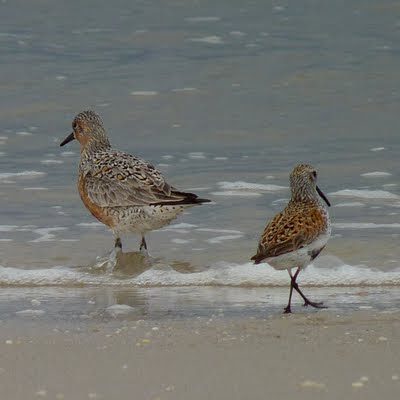An international effort is underway to monitor the remaining population and push for conservation of the habitats and resources the Red Knots need. Part of that is an ongoing banding program to study how birds use stopover sites and what migration routes they use. My friend Mary (whom I met through DC Audubon) knows some of the banders from her time in Australia, so she got invitations for the two of us to participate in a banding session this past weekend. Because of weather and tides, it turned out that Saturday was our best chance to participate, so we made sure to be at Reed's Beach early in the morning, even though we both arrived in Cape May rather late the previous night.
You can see how shorebirds are banded in a video I linked on this blog a few years ago. That shows a different set of banders in a different location, but the methods for capture and processing are essentially the same. The banding team prepares a net and disguises it as carefully as possible. Once enough shorebirds are in front of the net, the team fires cannons that propel the net over the birds. Some birds will escape, but many will be caught under the net. The banding team hurries to extract the birds from under the net as quickly as possible, so as to avoid unnecessary stress or injuries to the birds. Once all the birds are out of the net and into shaded containers, the banders can sit down and process them.
On Saturday, the captured birds went through several steps before their release. First they were banded and marked with coded tags to make it easier to recognize individuals in the field without recapturing them;* then a series of measurements were taken: weight, wing chord, and bill and head length; finally, feather samples were taken for lab analysis. One person recorded all of the codes and measurements for each bird. I was last in line, so I held each bird while another person snipped some feathers (one wing covert and two breast feathers), and then I released it. I think I probably handled a few dozen Red Knots in the course of the morning, though I was not keeping count.
It was really cool to hold the Red Knots and see them up close. One thing I had not realized when I looked at them through binoculars was just how intricate the patterns on their backs are. Their scapulars in particular have dark brown lines dividing each feather into sixths; the middle part of the feather is tinged with rufous while the tip is white. Meanwhile, their rumps are etched with fine barring, and their undertail coverts are speckled. The Red Knots were also smaller than I expected; I guess they look larger to me through binoculars than they do in the hand. A lot of these birds were recent arrivals, though, so it is possible I would get a different impression once they had time to gorge themselves on horseshoe crab eggs.
As I mentioned in yesterday's post, Mary and I went to Heislerville in the afternoon and evening to find a Curlew Sandpiper. Once we had found it, we helped with another banding project that is monitoring some of the species using the impoundments. That project is mainly concerned with Semipalmated Sandpipers, but it also bands Short-billed Dowitchers, Dunlin, and other shorebird species that happen to get tangled in the nets. Mary helped extract shorebirds from the nets, while I ferried birds from the nets to the banders or held nets so that they would not blow on a bird during the extraction process. Once again I was impressed by the birds' small size; the Semipalmated Sandpipers were especially tiny.
I really enjoyed my experience with shorebird banding this weekend, and I hope to do more of it when I have the chance.
* If you happen to see a Red Knot (or other shorebird) with color markings or a colored flag with an alphanumeric code on it, please report it to bandedbirds.org.








